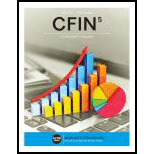
Concept explainers
Capital Structure of any company is the mix of different levels of debt and equity. An optimal capital structure is the appropriate mix of debt and equity, striking a balance between risk and return to achieve the goal of maximizing the price of the firm’s stock. Therefore, a target proportion of capital structure and cost of each financing can be used to determine the WACC of the company.
Weighted Average Cost of Capital (WACC) is the required
Here,
Proportion of debt in the target capital structure “
Proportion of preferred stock in the target capital structure “
Proportion of equity in the target capital structure “
After tax cost of debt, preferred stock,
EPS analysis at a given level of EBIT helps in determining the optimal capital structure of the firm, that is the structure at which the EPS will be the highest.
Firm LM’s debt to asset ratio is 25%, total assets is $800,000, EBIT is $60,000 and number of shares outstanding is 15000 with an interest rate of 8% Firm QR on the other hand, has debt to total asset ratio of 50% with $400,000 as assets, $70,000 as EBIT. It has an interest rate of 10% and has 25,000 shares outstanding. Marginal tax rate is 40% for both the firms.
Trending nowThis is a popular solution!

Chapter 12 Solutions
CFIN (with Online, 1 term (6 months) Printed Access Card) (New, Engaging Titles from 4LTR Press)
- Generous Corporation has a cost of equity of 10.8 percent, the YTM on the company's bonds is 6.3 percent, and the tax rate is 35 percent. The company's bonds sell for 103.6 percent of par. The debt has a book value of $420,000 and total assets have a book value of $956,000. If the market-to-book ratio of equity is 2.86 times, what is the company's WACC? 8.90% 780% 9.32% 792%arrow_forwardSkolits Corp. has a cost of equity of 11.8 percent and an aftertax cost of debt of 4.44 percent. The company's balance sheet lists long-term debt of $340,000 and equity of $600,000. The company's bonds sell for 104.1 percent of par and market-to-book ratio is 2.80 times. If the company's tax rate is 39 percent, what is the WACC?arrow_forwardImperial Industries has $400,000 in short-term debt and $2.6 million in long-term debt. Their preferred shares sell for $50.00 each, and their are 100,000 shares outstanding. Imperial's common stock sells for $32.00 per share, and there are 1 million shares outstanding. Use these data to calculate the value of Imperial's preferred equity, common equity and Debt . Calculate the value to the nearest dollar.arrow_forward
- Creation Landscaping has 1,000 bonds outstanding that are selling for $1,280 each. The company also has 2,000 shares of preferred stock outstanding, currently priced at $27.20 a share. The common stock is priced at $37.00 a share and there are 28,000 shares outstanding. What is the weight of the debt as it relates to the firm's weighted average cost of capital? Group of answer choices 43.08 percent 45.16 percent 47.11 percent 54.00 percent 55.45 percentarrow_forwardChisel Corporation has 3 million shares outstanding at a price per share of $3.25. If the deb-to-equity ratio if 1.7 and a total book value of debt equals $12,400,000, what is the market-to-book ratio for Chisel Corporationarrow_forwardMV Corporation has debt with market value of $95 million, common equity with a book value of $101 million, and preferred stock worth $22 million outstanding. Its common equity trades at $45 per share, and the firm has 5.6 million shares outstanding. What weights should MV Corporation use in its WACC? The debt weight for the WACC calculation is 25.74% The preferred stock weight for the WACC calculation is 5.96% The common equity weight for the WACC calculation is __ % ? (Round to two decimal places.)arrow_forward
- MV corporation has debt with market value of $101 million, common equity with a book value of $102 million, preferred stock worth $17 million outstanding. It’s common equity trades at $46 per share, and the firm has 5.6 million shares outstanding. What weights should MV corporation use in its WACCarrow_forwardAAA Corporation and BBB Corporation are identical in every way except their capital structures. AAA Corporation, an all-equity firm, has 30 million shares of stock outstanding, currently worth $55 per share. BBB Corporation uses leverage in its capital structure. The market value of BBB’s debt is $400mil., and its cost of debt is 4.5 percent. Each firm is expected to have earnings before interest and tax of $165mil. in perpetuity. Assume that every investor can borrow at 4.5 percent per year. Corporate tax rate is 40%. Q14. How much will it cost to purchase 20% of BBB's equity?arrow_forwardAAA Corporation and BBB Corporation are identical in every way except their capital structures. AAA Corporation, an all-equity firm, has 45 million shares of stock outstanding, currently worth $50 per share. BBB Corporation uses leverage in its capital structure. The market value of BBB’s debt is $400mil., and its cost of debt is 3.5 percent. Each firm is expected to have earnings before interest and tax of $155mil. in perpetuity. Assume that every investor can borrow at 3.5 percent per year. Corporate tax rate is 35%. Q18. BBB is about to undertake a new project. Initial outlay for the project is $1.5 billion. The project is expected to generate annual after-tax free cash flows of $65 million indefinitely. If the project has similar risk characteristics to those of BBB company as a whole, and if it could be financed with the same financing proportions that the company currently uses, what would be the project’s net present value (NPV)? (with the rounding, choose the answer that is…arrow_forward

 EBK CONTEMPORARY FINANCIAL MANAGEMENTFinanceISBN:9781337514835Author:MOYERPublisher:CENGAGE LEARNING - CONSIGNMENT
EBK CONTEMPORARY FINANCIAL MANAGEMENTFinanceISBN:9781337514835Author:MOYERPublisher:CENGAGE LEARNING - CONSIGNMENT Financial Reporting, Financial Statement Analysis...FinanceISBN:9781285190907Author:James M. Wahlen, Stephen P. Baginski, Mark BradshawPublisher:Cengage Learning
Financial Reporting, Financial Statement Analysis...FinanceISBN:9781285190907Author:James M. Wahlen, Stephen P. Baginski, Mark BradshawPublisher:Cengage Learning



